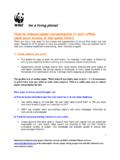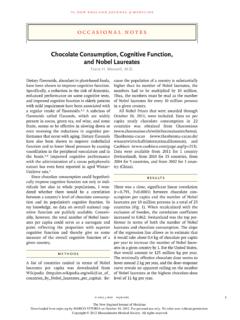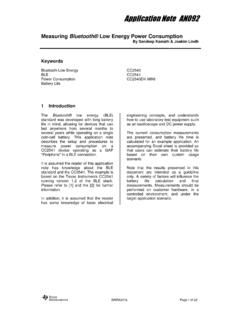Transcription of Guidelines for Hauling and Transporting Regulated Water ...
1 1 Guidelines for Hauling and Transporting Regulated Water for Human consumption Navajo Nation Environmental Protection Agency Public Water Systems Supervision Program This document provides Guidelines for Hauling and Transporting Regulated Water for Human consumption for use by companies, associations, and individuals who deliver/ haul potable Water to the public. These Guidelines have been developed to provide technical guidance for proper Water Hauling procedures and practices that should be followed to assure the safety of public health and Water quality. Water borne illness can be minimized by using these Guidelines . Background The Colorado Plateau consists of four states: Arizona, Utah, Colorado, and New Mexico. This is also the location of the Navajo Reservation, which according to the Official Navajo website, covers over 27,000 square miles. ( , 2010). The Navajo Nation is the largest reservation in the United States.
2 Some Navajos living in rural communities across the Navajo Nation do not have access to Regulated Water for human consumption . Many families hauled their drinking Water from unregulated Water sources, windmills, community wells, or natural springs. Windmills were developed by the Navajo Department of Water Resources for livestock use. Hand pump wells were installed by the Public Health Service (PHS) in the 1950 s and 1960 s to help Navajos address the need for Water . Most hand pump wells were placed in washes. Natural springs are natural flowing Water coming out of the ground and /or sandstone and do not have infrastructure (pipe or other fixtures). Studies from Northern Arizona University with the Native American Cancer Research Partnership show that people who reside in rural isolated communities in the Southwest portion of the Navajo Reservation use unregulated Water for human consumption .
3 The Cameron and Leupp Chapters isolated rural communities use unregulated Water sources as their primary source for drinking Water . The University Of New Mexico s Community Environmental Health Program ( ) and the Dine Network for Environmental Health Project (DiNEH Project) showed similar results within the Eastern Agency, where unregulated Water sources are used as their primary drinking Water sources for human consumption . In an effort to understand the Water quality from these unregulated Water sources across the Navajo Nation, the NNEPA, along with the Environmental Protection Agency (USEPA), Region 9, and the Centers for Disease Control and Prevention (CDC) have been taking Water samples from known unregulated Water sources that communities have been using. The results show that some of the wells are high in heavy metals exceeding primary and secondary drinking Water standards.
4 The results also show that there are a number of cases of Water borne bacteria, a concern for public 2 health. NNEPA in collaboration with USEPA, Region 9, and CDC will continue sampling Water sources. Wells exceeding the primary standards have been tagged by the NNEPA with a yellow flyer stating that the well exceeds the primary standards for human consumption . The DiNEH Project with USEPA, Region 9, began an outreach campaign in the communities of Cameron, Leupp, and the Eastern Navajo Agency, where it is known that community members use unregulated Water source as their primary source for drinking Water . The collaborators attended chapter planning meetings, provided handouts, and developed promotional items in the Navajo and English languages. USEPA, through the Indian Set Aside funds of the Safe Drinking Water Act, and the Indian Health Service have worked to address the lack of access to drinking Water issue.
5 Many drinking Water projects were funded by these organizations and most recently, USEPA, Region 9, awarded the Navajo Nation with five Water Hauling trucks to deliver potable Water to homes or communities that have no access to Regulated Water sources. While addressing access to safe Water these Water Hauling Guidelines should further promote safe Water Hauling practices. Project Objective The project objective is to promote safe Hauling practices in Transporting Regulated Water for human consumption . There are two classes of Water haulers identified. They are: a) Bulk Water Hauler- Bulk Water haulers use commercial vehicles to haul Water to homes or communities using a 1000 gallon drum, or more, to community members. Bulk Water haulers are also people that have use trailers or have Water containers mounted on their vehicle. b) Light Water Hauler- Light Water haulers using less than 1000 gallon drums or less, to haul potable Water for human consumption .
6 Container The types of containers that are recommended for bulk Water Hauling include: a) A FDA approved bulk Water Hauling unit that is only used for human consumption and will not be used for livestock Water Hauling . b) An inspected and approved bulk Water Hauling unit that is mounted on a truck or a trailer. c) Mounted Water haulers and trailers should be certified by National Sanitation Foundation (NSF) or American Water Works Association (AWWA) standards. Stainless steel material is recommended for mounted bulk Water haulers and people using trailer. 3 Registration/Inspections/ Samples 1) All bulk Water haulers who supply Water for potable use must register with the Navajo Nation EPA, Public Water Systems Supervision Program. For the light Water haulers, it is recommended that they follow the Guideline for Hauling and Transporting Regulated Water for Human consumption .
7 ( , this documents).. 2) The NNEPA, Public Water Systems Supervision Program will inspect all facilities to be used by the bulk hauler and the hauler s records of the past year to assure compliance with the requirements in these Guidelines . 3) Following registration, the NNEPA, Public Water Systems Supervision Program will conduct periodic inspections. A certified Water operator will be required to collect Water samples for bacteriological and /or chemical analysis as deemed necessary for the equipment being used to haul Water . 4) The combine chlorine residual in the Water being hauled should have a minimum level of mg/L, thereby combating bacterial problems. Chlorine residual information will be kept in a log book by the Water haulers. If the Water is being hauled from a Regulated Water source, the bulk Water hauler should be tested once a month. Source 1) Water shall be obtained from a Regulated public Water system.
8 2) All transported Water shall be proven bacteriological safe and comply with the primary drinking Water standards. The National Primary Drinking Water Regulations from US EPA is attached at the end in the appendix. The web address is for the National Primary Drinking Water Regulations. Navajo Tribal Utility Authority has a Consumer Confident Report on their website at 3) Water shall be obtained from a predetermined point of access to the public Water system. Information about this point of access ( , location, frequency of use) is submitted to the NNEPA, Public Water Systems Supervision Program prior to its use. The Water should be withdrawn from the treatment plant and not from fire hydrants or dead-end lines. 4) All Water supply valves must be in good condition and must not leak. 5) There must be a backflow prevention device in place to prevent that as well. Handling of Equipment 1) A bulk Water Hauling container used for Hauling other than potable Water shall not be used and will not be approved unless their prior use and reconditioning is documented that the container does not pose a public health risk and the use of the reconditioned container is approved by the NNEP, Public Water Systems Supervision Program.
9 2) All tankers shall be marked clearly with a sign Drinking Water Only 3) A protected vent must be provided for each tanker to assure that negative pressures do not occur during delivery which might create a potential for backflow from the customer s system. 4 4) There shall be a covered opening of sufficient size to enable the inside of the tank to be cleaned and inspected. 5) All the Water contact surfaces shall be smooth, impervious and free of corrosion. Coatings must be non-toxic and of a type that will not flake off in the Water . Only non-toxic coatings approved by the NSF may be used on the Water contact surfaces. 6) The Water hose must be for potable Water use only. Any other equipment used besides hoses such as extension pipes must be cleaned with proper disinfection methods. The hoses must be made for drinking Water , such as those for RVs and boat. 7) Bulk Water haulers must clean, disinfect, and maintain the Water truck after each delivery.
10 A log book to document each delivery, each cleaning, each disinfection, and each sampling event is recommended. The log book must be made available to the NNEPA personnel that inspect the equipments. 8) No bulk Water hauler shall have Water stored in the tank overnight. Records 1) Each hauler must keep a detailed log for at least one year after delivery which includes: a. The course of Water and its points of withdrawal. b. Date and time of pick-up and delivery. c. The name of the driver of (or other responsible person with) the tank truck. d. Free Chlorine residual. e. Description of maintenance activities, such as cleaning and disinfection of the trucks and containers. f. Record of inspections, including follow-up activities resulting from the inspection results. Water Storage Equipment 1) The Water drums that are being utilized by the customers for storage must comply with the FDA requirement for storing potable Water .







